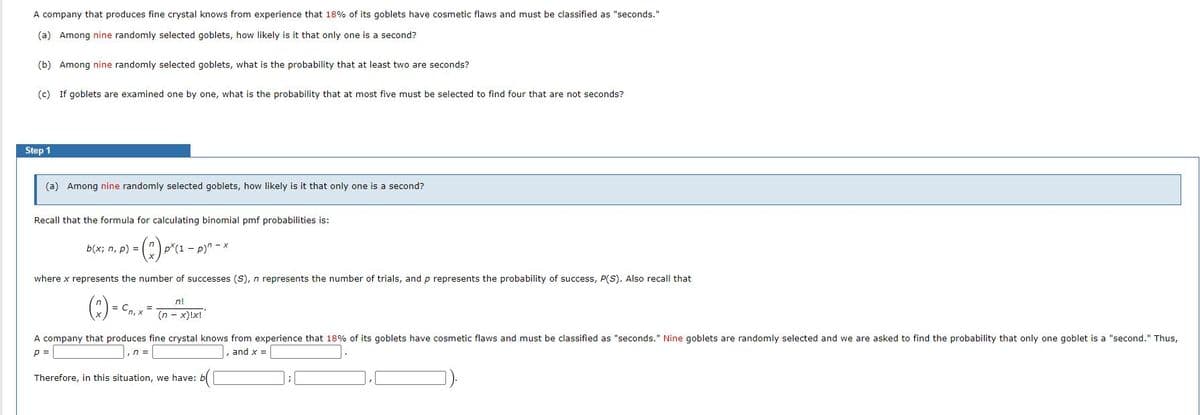(a) Among nine randomly selected goblets, how likely is it that only one is a second? Recall that the formula for calculating binomial pmf probabilities is: b(x; n, p) = where x represents the number of successes (S), n represents the number of trials, and p represents the probability of success, P(S). Also recall that (:). ni C Tn- x)lx A company that produces fine crystal knows from experience that 18% of its goblets have cosmetic flaws and must be classified as "seconds." Nine goblets are randomly selected and we are asked to find the probability that only one goblet is a "second." Thus, and x Therefore, in this situation, we have: b
(a) Among nine randomly selected goblets, how likely is it that only one is a second? Recall that the formula for calculating binomial pmf probabilities is: b(x; n, p) = where x represents the number of successes (S), n represents the number of trials, and p represents the probability of success, P(S). Also recall that (:). ni C Tn- x)lx A company that produces fine crystal knows from experience that 18% of its goblets have cosmetic flaws and must be classified as "seconds." Nine goblets are randomly selected and we are asked to find the probability that only one goblet is a "second." Thus, and x Therefore, in this situation, we have: b
Holt Mcdougal Larson Pre-algebra: Student Edition 2012
1st Edition
ISBN:9780547587776
Author:HOLT MCDOUGAL
Publisher:HOLT MCDOUGAL
Chapter11: Data Analysis And Probability
Section11.8: Probabilities Of Disjoint And Overlapping Events
Problem 2C
Related questions
Question
This question has multiple parts. Can fill in the boxes for part A

Transcribed Image Text:A company that produces fine crystal knows from experience that 18% of its goblets have cosmetic flaws and must be classified as "seconds."
(a) Among nine randomly selected goblets, how likely is it that only one is a second?
(b) Among nine randomly selected goblets, what is the probability that at least two are seconds?
(c) If goblets are examined one by one, what is the probability that at most five must be selected to find four that are not seconds?
Step 1
(a) Among nine randomly selected goblets, how likely is it that only one is a second?
Recall that the formula for calculating binomial pmf probabilities is:
b(x; n, p) =
p*(1 p)"-
where x represents the number of successes (S), n represents the number of trials, and p represents the probability of success, P(S). Also recall that
(:) -
n!
= Cn, x =
(n-x)!x!
A company that produces fine crystal knows from experience that 18% of its goblets have cosmetic flaws and must be classified as "seconds." Nine goblets are randomly selected and we are asked to find the probability that only one goblet is a "second." Thus,
p =
,n =
, and x =
Therefore, in this situation, we have: b
Expert Solution
This question has been solved!
Explore an expertly crafted, step-by-step solution for a thorough understanding of key concepts.
This is a popular solution!
Trending now
This is a popular solution!
Step by step
Solved in 2 steps

Recommended textbooks for you

Holt Mcdougal Larson Pre-algebra: Student Edition…
Algebra
ISBN:
9780547587776
Author:
HOLT MCDOUGAL
Publisher:
HOLT MCDOUGAL


Algebra and Trigonometry (MindTap Course List)
Algebra
ISBN:
9781305071742
Author:
James Stewart, Lothar Redlin, Saleem Watson
Publisher:
Cengage Learning

Holt Mcdougal Larson Pre-algebra: Student Edition…
Algebra
ISBN:
9780547587776
Author:
HOLT MCDOUGAL
Publisher:
HOLT MCDOUGAL


Algebra and Trigonometry (MindTap Course List)
Algebra
ISBN:
9781305071742
Author:
James Stewart, Lothar Redlin, Saleem Watson
Publisher:
Cengage Learning